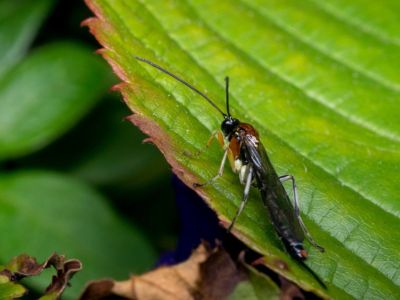What are Predatory Wasps?
Although there are many different types of predatory wasps, most of them have a few things in common. They are generally 1/4-inch (0.5 cm.) or so in length and capable of delivering a painful sting. They vary in appearance, but most of them have bright yellow or orange bands of color. The flashy colors act as a warning to any animal that may want to eat them. All predatory wasps have four wings and a skinny, thread-like waist that connects the thorax to the abdomen. You may encounter some of these predatory wasps in gardens:
Braconids are small predatory wasps that measure less than one-quarter inch (0.5 cm.) in length. Adults like small flowers with open centers that contain nectar. They sting their prey and lay eggs inside the prey’s body. Braconids are very important predator wasps for the control of caterpillars. Ichneumonids are a little larger than braconids. They make their cocoons under the skin of their prey, usually caterpillars or beetle larvae. Tiphiids and scoliids are larger than predator wasps. They resemble carpenter ants with wings. Females can deliver a mild sting. The females burrow into the ground and lay their eggs inside beetle larvae. They are important in the control of Japanese beetles and June bugs. Trichogrammatids, scelionids, and mymarids are no bigger than the period at the end of this sentence. They help control caterpillars such as cabbage loopers and cabbageworms. Eulophids are medium-sized parasitic wasps that are usually metallic green or blue in color. Some types help control Colorado potato beetles by parasitizing their eggs, while others parasitize the adult insects. Unfortunately, they sometimes parasitize other parasitic insects. Pteromalids are less than one-eighth inch (0.5 cm.) long and solid black with distinctive red eyes. Female pteromalids parasitize pupating caterpillars and beetle larvae by laying eggs inside them.
